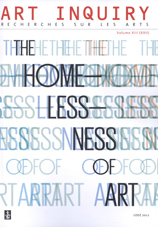Geometric art and the idea of belonging
Geometric art and the idea of belonging
Author(s): Paulina SztabińskaSubject(s): Fine Arts / Performing Arts
Published by: Łódzkie Towarzystwo Naukowe
Keywords: geometric art; belonging; rootedness; space; light; memorial
Summary/Abstract: The starting point of the article is a short discussion of the problems connected with the understanding of the notions of “space,” “place,” “belonging” and “rootedness.” I mostly refer to the findings of humanistic geography and phenomenological philosophy. Next, I ask whether it is possible to apply those notions in the currents of modern art using geometric forms. The artists who created such works in the first half of the 20th century, usually assumed the idea of abstract space. They rejected the features associated with the “attachment to a place,” treating them as limiting, not allowing for the opening of art to infinite space and universal problems. As regards the works of art, their connection with specific places, with the objects from their immediate surroundings, neighbourhood or homeland was regarded as limiting. One of the reasons why representational art was rejected at that time was its interest in that kind of “trivial”content. However, the creators of geometric art did not give up the idea of settlement. They only assumed that it should take place in infinite space that was to become a specific kind of a “home” without walls and borders. In the last decades of the 20th century, universalistically conceived space was subjected to criticism, also by the representatives of geometric art. They felt the increasing need to refer to concrete things from their nearest surroundings. However, they referred to them in a specific way – not by accepting the “old” possibilities of taking root, but by looking for new ones. The article discusses three types of such actions. On the basis of Jan Berdyszak’s works, it considers the possibility of settling in concrete emptiness. On the basis of Antoni Mikołajczyk’s installations, it discusses the notion of settling in through light. Finally, by considering specific examples of memorials in which geometric elements serve the preservation of the memory of certain events from the past, I discuss the new possibilities offered by such art to the public, which can get immersed in the experiences relating to such situations as the Vietnam War (the memorial by May Lin), the Warsaw Uprising (Maciej Szańskowski’s project) or the Holocaust (Peter Eisenman’s memorial in Berlin).
Journal: Art Inquiry
- Issue Year: 2011
- Issue No: 13
- Page Range: 229-248
- Page Count: 20
- Language: English

